![[Metroactive Arts]](/arts/gifs/art468.gif)
[ Arts Index | Silicon Valley | Metroactive Home | Archives ]
Revolution in a Paint Can
Art groups redefine themselves in postmillennial, post-boom San Jose
By Traci Vogel
TWENTY-FIVE YEARS is not a long time in the art world, where a painting's value doesn't begin to increase until the artist is 6 feet under for 60 years, but in the world of nonprofits, a quarter of a century represents an eternity. Which is why the 25th anniversary of WORKS/San Jose, this month, rates more than a "but I know what I like."
WORKS/San Jose, a nonprofit gallery and studio space, has led a peripatetic and necessarily peripheral existence in the Silicon Valley, starting downtown in 1977 and morphing through various locations and with various levels of success, only to settle back downtown on North Third Street in 1996, thanks to the city of San Jose's Redevelopment Board and the Arts Council Silicon Valley.
Maybe all this wandering explains the airy feel to the interior of WORKS, which is constructed with raw edges within the skeleton of an old taxi-mechanics' shop. The space undergoes radical changes with each show. Once, an artist carted tons of dirt into the gallery and shaped them into a giant ramp. Another time, a child's playhouse was suspended from the rafters.
WORKS is not an artists' co-op. The distinction means that while the gallery is member-staffed, it does not limit itself, as co-ops do, to exhibiting only its members' creations. WORKS shows artwork by people from San Jose to Saigon. A look at some of its past gallery exhibits reveals an art groupie's crush-book of artists, including Laurie Anderson, Jock Reynolds, Leif Brush, Lynn Hershman, Alan Rath, Holly Lane, Mark Pauline of Survival Research Laboratories, Malaquis Montoya, Ed Osborn and Yolanda Lopez--and what's more, many of these famous names were shown before fame found them.
WORKS' curatorial system is also emphatically democratic. The board members prefer proposals from groups of artists, organized around themes and communities, and do not "scout" for artists as commercial galleries do. The board rotates responsibility, and there is no permanent director.
All of which, smacking of the end-of-history love of chaos and Marxist tendencies that mark most real artistic ventures, only adds to the surprise that WORKS has been as successful as it has.
But what is even more surprising is that, after 25 years, WORKS still holds its cutting edge, still inspires up-and-comers. The gallery's mantra of inclusion, its anti-institutionalism, its mission to "demystify" art, its working-artist studios, and the consistent high quality of its shows, coupled with its intimate size, make a contemporary art appreciator giddy. It also makes the same art appreciator wonder, Why is such an obvious model so hard to follow?
Finder's Guide: Art venues in the South Bay.
How to Be an Artist in 700 Difficult Steps
Here's the problem: San Jose is a good place to show art, but not such a good place to actually be an artist. What with the continuing high rents, the dearth of live/work spaces, the lack of a center to foster communication among artists, and limitations on funding, artists find it difficult to eke out an existence--and they often completely fail.
"Two things happen," says Robert Milnes, head of the Fine Arts Department at San Jose State University. "A lot [of artists] leave, and others go into other forms of employment.
"When we talk about the city," Milnes elaborates, "one of the things that people have been discussing lately is that what we get here a lot is the consumption of art--people see plays; people go to theater; there's a wonderful museum; [there's] the Institute of Contemporary Art, WORKS--all very valuable. But there's very little structure for the production of art here. For visual art, there are very few venues that really foster the sale of art. It's wonderful to see art, but if it doesn't get sold, the artists have a hard time producing again."
Pilar Agüero-Esparza, director of visual arts at MACLA (Movimiento de Arte y Cultura Latino Americana), agrees. She says that during the economic boom over the past few years, public funding allowed for big improvements to the city's arts institutions, but no consideration was made for basic infrastructre, like working studios and affordable housing.
"The bigger institutions have done quite a bit for midcareer artists, but more emerging artists--that's a different thing," Agüero-Esparza says.
MACLA itself, which was founded in the early 1980s in order to establish a Latino arts presence downtown, just celebrated its 10th anniversary of exhibiting visual arts. The gallery has recently added a small stage to accommodate spoken-word, theatrical and musical events.
Grants to emerging artists are also a primary goal of the center. In the last fiscal year, MACLA exhibited 79 artists, supporting them to the tune of $134,000. Like WORKS, MACLA's space has a vibrant, communal feel. Agüero-Esparza emphasizes MACLA's ongoing interest in its artists' welfare, not just in their art.
"Something that's exciting is to find someone who's been a student and then see what they're doing three to four years later--hopefully, they're still in San Jose," Agüero-Esparza says.
"In terms of individual artist fellowship, the Arts Council here does have cash awards to give out for projects--but that emphasizes people who have been working for a while. I do wish there could be larger grants, given out more often and more broadly. ... There's a lot of money here in Silicon Valley, but it doesn't seem the Arts Council has been able to get to that."
Ideally, Agüero-Esparza thinks, the artists themselves should be more involved in the process. "More work has to be done with artists organizing themselves," she says. "WORKS is a good example of that. I think their programs have been quite powerful and successful. I'm just not sure there's a good entity out there for artists to organize [around]."
Draw, Click and Mail
Steve Faustina, a 28-year-old artist three classes away from graduating from SJSU, thinks the Internet is that entity. Faustina co-founded Alternative Online Artists (www.art-aoa.com), an online artist co-op that uses eBay as its gallery medium. The group consists of 30 artists across the United States, and these members vote on artists and artwork to be included.
Faustina has been selling his artwork--a blend of dada collage, graffiti and illustration--through AOA for almost a year and a half. He has shipped work to nearly every state in the United States, as well as to London and Taiwan.
To Faustina, San Jose is merely a mailing address. "I don't think it's a great place [to be an artist]," he says. "There's art here, but the only visible art is not what I'm into. Take the Shark Byte thing--the [artist] funding concept was appealing, but after seeing them I'm glad I didn't do one. They just made it obvious--this city is kind of dead to any art."
Like many young artists, Faustina sees street art, or outsider art, as a vibrant scene that galleries and city arts commissions for the most part ignore. "Street art is my main focus," he says. "Graffitti--even if some little kid draws a face on a pole--that's art, to me. But here it gets cleaned within a week."
Faustina finds his real community and influences on the Internet, and he runs his artistic endeavors like a business. In fact, it's almost overwhelming him, in a treadmill sort of way. He says he wishes he could "work faster," and he has switched over to creating smaller works, since they show and ship better.
"I have to think of it as a production system," Faustina says, "so I won't be so attached to [the artwork]. Some days I'll do 10 things; some days I'll do one. What's great is that people are buying directly from me, the artist. But every week I have to go to the post office and ship them. It's a little distracting, but I like it. It wouldn't be so bad if I wasn't so short on time."
Encouraging Revolution
The web might be a good place to find virtual inspiration, but it hardly beats actual flesh-and-blood interaction. Brian Eder knows this. When Eder, who co-founded Two Fish Design in Mountain View with his partner Cherri Lakey, decided last year to move his business to San Jose and to open a corresponding warehouse gallery, he says he knew there were young artists here--there was just no place for them to hang out, and nobody ever met one another. So Eder opened up Anno Domini.
"I grew up in San Jose," Eder says. "And when we decided to move Two Fish Design, we realized we could either come back this way or move to San Francisco. There was a time when we were thinking, Do we really want to come back here? But there's so much of the same thing going on in San Francisco, and we saw such a potential in San Jose that we decided to do it here. Because that stuff exists here; it's not like it doesn't exist. There's just no place for it to thrive."
"That stuff," to Eder, is the emerging intersection between art and design--the surfacing of street art into popular consciousness. "Anno Domini's tagline is 'The second coming of Art & Design,' and it was really because we felt like there was a synergy of art and design starting to rise up a few years back," he explains. "[Artists] are trying to explore the next place to take that. We decided we wanted to give them a place to come together and help that culture thrive."
A.D.'s First Friday artist receptions are the rock concerts of the Silicon Valley art world. In his quest to help culture thrive, Eder throws down turntablists at his gallery receptions, puts out T-shirts and has started a quarterly flier called Village Savant: Your Guide to a Creative Existence, which features events at A.D., Circle A Gallery, New Skool Tattoo, and Art Made to Match. A.D.'s DIY ability to create hype around events, combined with a hip-hop aesthetic sensibility, draws the kind of customers who wouldn't normally enter a commercial gallery.
"We're really trying to help younger people who would normally go out and buy rock posters. We're trying to turn them on to desiring something more," Eder says. "We talk to our artists about making sure there's always something for the young collector to buy, even if it's just a T-shirt with an original piece of art on it. Traditional galleries do representation well, but our thing is, first, giving [artists] a place to show; then we start searching for other channels and outlets for them to show art or help them make a living doing art. That's where the design company side is a good match."
Eder thinks San Jose is finally starting to catch on to the art in its midst. "It seems like, especially in the city's structure, in the political structure, they're starting to realize the importance of art in the community," he says.
"We [he and Lakey] were project directors for the Shark Byte art. There was a lot of weird political stuff going on, but the thing we felt most strongly about getting involved for is that it would definitely create a sort of emptiness of art when it left, in the street space. In Europe, you walk out into the street, and you're surrounded by art and culture; here, there's empty store fronts."
Lofty Plans
If Pat Colombe, principal planner at San Jose's Planning and Code Enforcement Department, has her way, that won't be true for long. Colombe is in charge of a proposal that, although still in its nascent stage, may foretell a radical change in the way San Jose relates to its redheaded stepchildren (that's a fancy metaphor for "artists").
The project would be centered in the Spartan Keys neighborhood, south of 280. The neighborhood used to be a center for the fruit canning industry, and there are remnants of this history in the old warehouses and Victorian houses there. Many of these buildings already house artists, and San Jose State University's metal foundry is located in the area.
In fact, the plan Colombe is putting forth was directly influenced by the university, whose art department has been looking for a space to expand its ceramics and glass-blowing studios. This push, coupled with the fact that the area is already zoned for artist, retail and high-density usage, allowed the city to look into reshaping the neighborhood as an arts core.
Colombe describes the proposal's ideal as a mix of low-income housing, studio space, live/work space in various permutations, retail, gallery and artist display space.
"The remainder," she continues, "would be a public park that would have historic industrial buildings remaining on it, potentially housing arts purposes--public in nature--run by the university or the recreation department. The university has expressed an interest in taking more of a public education role, and these buildings could potentially house those classes."
Colombe recognizes that the city has not been traditionally conducive to arts production, because of lack of housing and space, and she feels this proposal addresses those needs in a creative way.
She also recognizes that other cities--most notoriously San Francisco, of course--have found that artist housing can work as a way for developers to work development plans to their advantage. To keep that from happening, Colombe says, the lofts would be very basic.
"San Francisco developers have added a lot of finish to their lofts so they're very attractive, yes, but also expensive," she says. "But artists don't really need hardwood floors, expensive cabinetry, expensive tile--they need something really basic. We figure if the loft units are constructed so they have what the artists need in form, but not extras, they won't be as attractive to people who would otherwise be interested."
Colombe is aware of one other project, just to the north of the Spartan Keys neighborhood, that will include 16 artists' lofts and has been given the go-ahead. But it doesn't address the idea of a neighborhood focused on arts in the way the Spartan Keys project does. So what are the possibilities that it will actually get done?
The goods news, Colombe says, is that "we now have a community out there who is looking into developing the same sort of thing independently. The community itself has noticed the same opportunities, identified the same needs, and we are working with them."
"Success to me," Colombe says, "would be that the area gained a kind of reputation as a place where artists could live and work in a conducive, congenial environment--that to me would be a success. We're going to have a piece of that, I'm sure."
Is It Warm in Here?
Might all of this, in the glow of WORKS' 25th anniversary, represent the stirrings of a zeitgeist? Could San Jose, in the midst of a handy recession, become the Art Town it deserves to be? Might there actually be something radical out there that will be able to find the blood it needs to surface? Will local artists finally become the minor celebrities they deserve to be? Will a mural be appearing soon near you?
Consider this a call to arms.
[ Silicon Valley | Metroactive Home | Archives ]
Copyright © Metro Publishing Inc. Metroactive is affiliated with the Boulevards Network.
For more information about the San Jose/Silicon Valley area, visit sanjose.com.
![]()
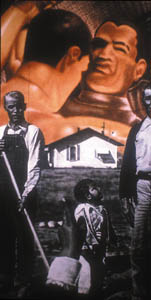 Old Haunts, New Haunts: In his series entitled Interruptions, Eugene Rodriguez explores with paint and photographs the dilemmas facing Chicano/Latino gay men when they seek relationships. Now appearing at MACLA.
Old Haunts, New Haunts: In his series entitled Interruptions, Eugene Rodriguez explores with paint and photographs the dilemmas facing Chicano/Latino gay men when they seek relationships. Now appearing at MACLA.
![[line]](/gifs/line.gif)
![[line]](/gifs/line.gif)
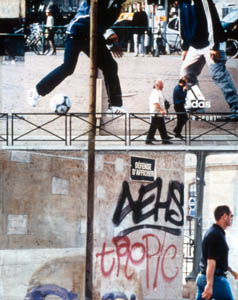 Art of Survival: 'Defense D'Afficher', by Kathryn Dunlevie, in acrylic and original photos.
Art of Survival: 'Defense D'Afficher', by Kathryn Dunlevie, in acrylic and original photos.
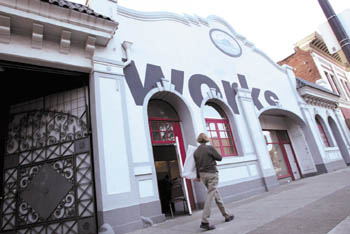
Edge of Enlightenment: WORKS, a nonprofit art gallery in downtown San Jose that has been a beacon for up-and-comers, celebrates its 25th year this month.
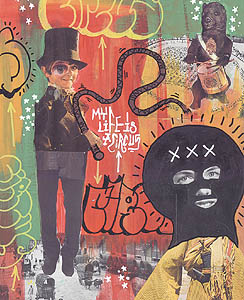 Lord of the Three Rings Mixed-media artist Steve Faustina combines graffiti, paint and photographic images for his circus-themed pieces, including the piece on Metro's cover this week.
Lord of the Three Rings Mixed-media artist Steve Faustina combines graffiti, paint and photographic images for his circus-themed pieces, including the piece on Metro's cover this week.
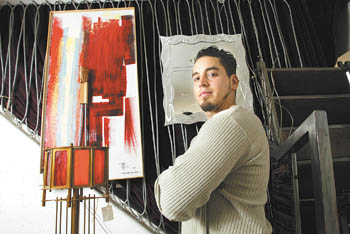
Match Maker Art Made To Match owner Edward Sakai uses his Willow Glen shop and gallery to show and sell art generated by both new and established artists.
WORKS/San Jose celebrates its 25th anniversary with a Members Show, featuring works by Mary Button Durrell, Eugene Rodriguez, Katherine Dunlevie, Hegge Binh and others. The show runs March 9 through April 5, with a reception March 8, 7-9pm. The gallery is open Tuesday-Saturday, noon-4pm (till 7pm Thursdays). 30 N. Third St., San Jose. (408.295.8378)
From the March 7-13, 2002 issue of Metro, Silicon Valley's Weekly Newspaper.